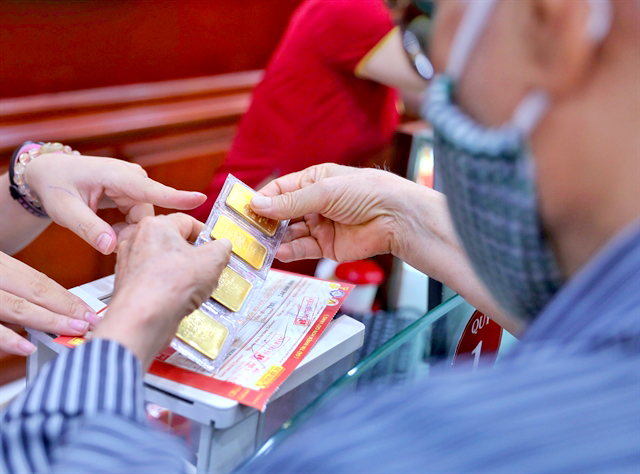 Business Beat
Business Beat


|
| A customer buys gold at Bảo TÍn Minh Châu Gold Company in Hà Nội. — VNA/VNS Photo |
Compiled by Yến Vy & Xuân Hiệp
HÀ NỘI — Although unable to maintain the record of VNĐ74.6 million (US$3,108) per tael in the early trading sessions of this week, SJC gold price has increased by more than VNĐ3 million per tael in November.
In the domestic market, gold prices continuously increased from November 27 until reaching an all-time record of VNĐ74.6 million per tael in the session of November 29.
Closing the weekend session, in the Hà Nội market, Saigon Jewelry Company listed SJC gold buying price at VNĐ72.7 million per tael and selling price at VNĐ74.02 million, an increase of VNĐ400,000 and VNĐ500,000 per tael compared to the previous session respectively.
DOJI Group listed SJC gold price at VNĐ72.3 million and VNĐ74 million per tael for buying and selling respectively, remaining the same for buying and increasing VNĐ500,000 per tael for selling compared to the previous session.
The world spot gold price increased 1.6 per cent to US$2,069.1 per ounce on December 1. Earlier this session, at one point, the gold price touched $2,075.09 per ounce and exceeded the all-time high of 2,072.49 established in 2020. Gold futures price in the US also increased to a record high of $2,089.7 per in this session.
In an interview with a Vietnam News Agency reporter, Shaokai Fan, director of Central Banks at the World Gold Council (WGC), said that recent gold price fluctuations in the Vietnamese market might reflect the complex relationship between global geopolitical factors, some specific conditions of the domestic market, and the sensitivity of investors with economic instability.
Sharing the same opinion, expert Trương Vi Tuấn of giavang.net added that in the past in early October, gold prices rose sharply when the conflict between Israel and Hamas broke out. Now, the price of gold is being fueled by investors' doubts about the interest rate management stance of the US Federal Reserve (Fed).
The expert predicted that in the context of a sharp increase in world gold prices, domestic gold demand would surge. This would lead to a further domestic gold price hike after slight adjustments, if any, he added.
Talking to Người Lao Động (The Labourer) newspaper, Nguyễn Thế Hùng, deputy chairman of the Việt Nam Gold Trading Association (VGTA), analysed that there were many supporting factors helping gold prices reach historic peaks.
Specifically, the US dollar price dropped sharply after the US Federal Reserve (Fed) meeting in early last month with the message of no further interest rate increases, helping gold prices benefit.
The US Dollar index (DXY) on Saturday was at 103 points, down 3 per cent over the past month. The sharp decline in US dollar price shows the possibility that the Fed will end its interest rate hike cycle and switch to a reduction cycle from mid-2024.
In this context, many investment funds, international financial institutions and central banks also increase their gold purchases. Therefore, world gold is forecast to reach $2,100 per ounce.
The increase in gold prices at this time was also due to the high demand for physical gold in countries that consume a lot of gold such as China, India, Turkey to produce gold jewellery for the year-end holiday season, Christmas season, and wedding season, said Hùng.
Some other experts also believed that the world gold price was aiming for $2,100 per ounce, however, the domestic gold price, especially SJC gold, was difficult to predict due to the large gap with the world.
If the market has more supply from raw gold imports as recommended by businesses to produce SJC gold or rings, jewellery, the price may decrease.
Credit growth management
The Government will conduct an inspection of credit growth management by the central bank in response to low credit growth.
During a meeting with the central bank last Friday, Deputy Prime Minister Lê Minh Khái instructed the central bank to continue to review regulations to flexibly manage monetary and credit policies.
The Government Inspectorate will need to report the inspection’s results in January 2024, he said.
As of the end of November, credit growth has only reached about 8.4 per cent, falling short of the year’s target of 14.5 per cent.
In addition, the uneven distribution of credit growth among lenders is another hurdle, with some banks having high levels of growth while others have reported extremely low growth in credit.
A supervisor at an HDBank branch in HCM City’s District 4, who requested anonymity, told Việt Nam News: “Most commercial banks now have excess liquidity due to a lack of credit.”
While there is an abundance of capital supply, the disbursement of loans has been challenging due to the sluggish economy, she said.
The credit standard could not be lowered in order to ensure system safety and prevent non-performing debt from increasing again, she noted.
Representatives of commercial banks have proposed relevant authorities continue to resolve legal obstacles related to the real estate market and work to stimulate domestic consumption, particularly during the upcoming Lunar New Year.
They have also called for the acceleration of public investment capital disbursement to boost investment and business activities in the economy.
The central bank last week announced it will adjust growth targets among credit institutions as a result of uneven credit growth.
Credit limits for certain banks will be changed based on their performance since the beginning of the year, with additional credit limits being granted to banks that have prioritised credit for key sectors and have lowered interest rates.
Experts have warned credit growth this year will only reach 12 per cent, as real estate and consumer loans for real estate, which make up 70 per cent of bank lending, have dropped significantly.
Exports and production are also facing difficulties, leading to a decrease in demand for capital.
The lower-than-targeted credit growth is a concern for the economy’s recovery in general, experts noted.
Prime Minister Phạm Minh Chính, speaking at multiple meetings, has also stressed the importance of increasing credit access and removing difficulties facing businesses.
The PM has consistently ordered the central bank to have flexible and efficient monetary policies to promote growth and ensure safety in the credit system.
Meanwhile, money continues to flow into banks despite low deposit rates of below 6 per cent per year, as deposits are still seen as a safe investment.
The level of deposits at banks has reached a record high of more than VNĐ6.44 quadrillion as of the end of September this year.
In a related issue, during the sixth session of the 15th National Assembly, the NA requested the Government enhance inspection of the banking sector, following several serious violations in the sector.
The most serious case involved the embezzlement of US$12.36 billion from Saigon Commercial Joint Stock Bank (SCB), leading to charges against Trương Mỹ Lan, chairwoman of Vạn Thịnh Phát Group, for embezzlement, violations of banking operations, and bribery.
After facing a bank run in October 2022, SCB was taken over by the central bank to minimise the negative impact to SCB customers and the overall sector.
The SCB scandal is the biggest in the country’s banking history to date. — VNS




